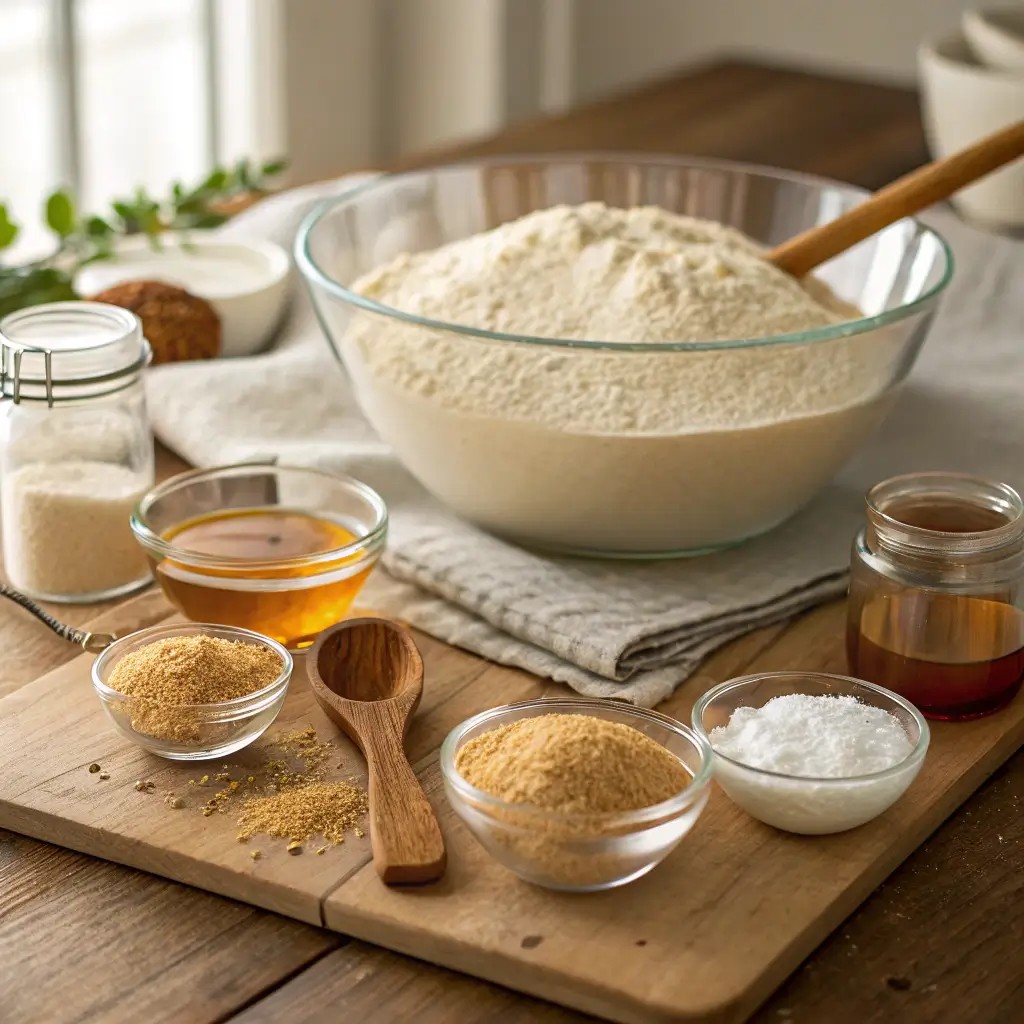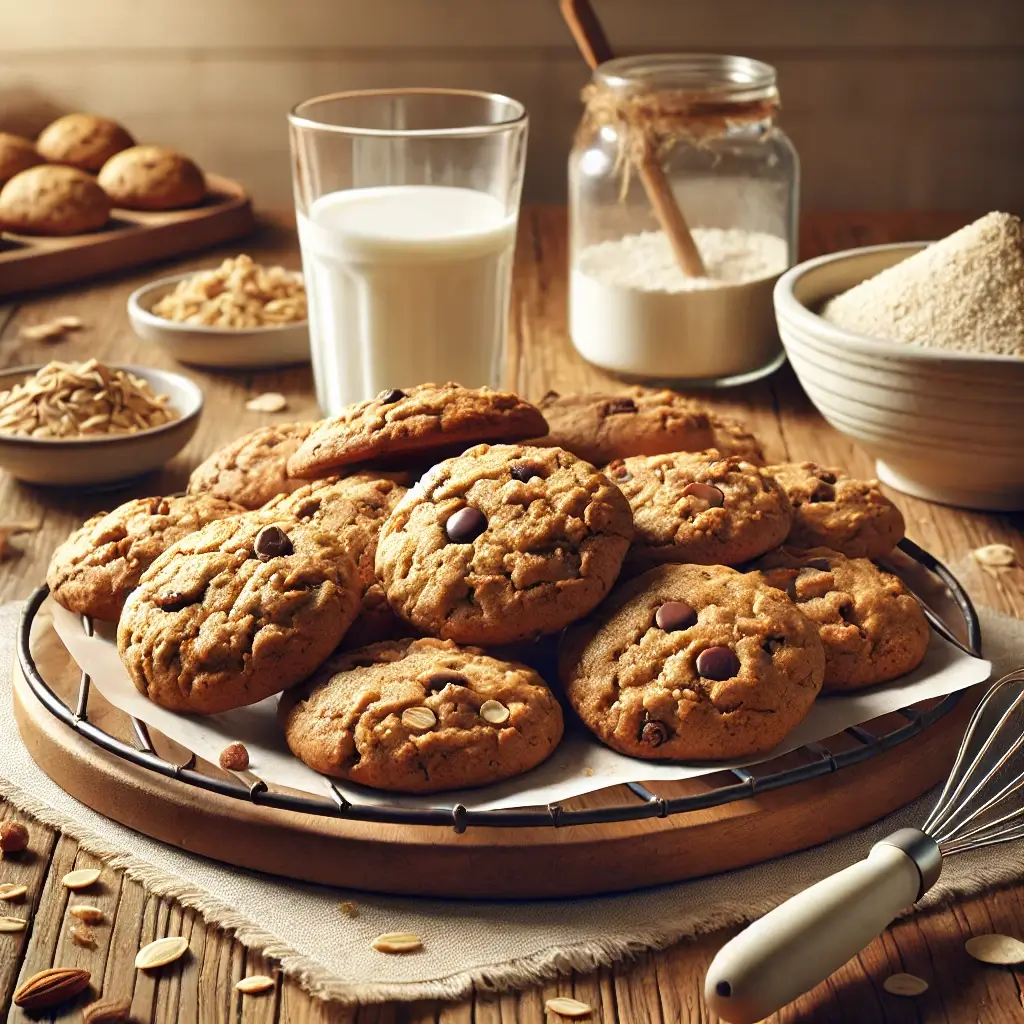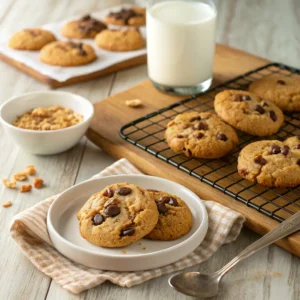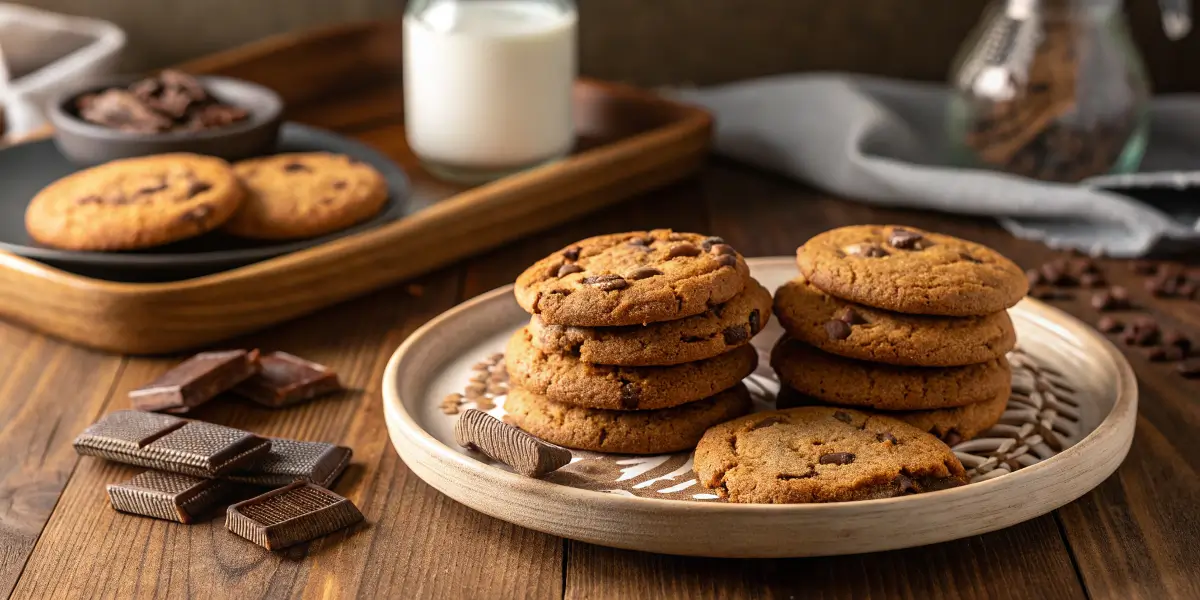Nothing beats the comforting taste of freshly baked cookies, but if you follow a gluten-free and plant-based lifestyle, finding the perfect gluten free cookie mix that’s both delicious and dairy-free can be a challenge. That’s why making your own mix at home is a game-changer—it allows you to control the ingredients, sweetness, and texture, ensuring every bite is just as satisfying as traditional cookies.
This vegan-friendly gluten free cookie mix is made with wholesome, plant-based ingredients like oat flour, almond flour, and coconut sugar, creating a soft, chewy texture without eggs or dairy. Whether you love classic chocolate chip, nutty oatmeal, or spiced cinnamon cookies, this mix is versatile and easy to customize with your favorite add-ins.
Perfect for quick baking, meal prep, or gifting, this homemade mix guarantees warm, freshly baked treats anytime. Ready to create the best vegan and gluten-free cookies from scratch? Let’s get started!
Why Choose a Gluten Free Cookie Mix?
Gluten-free baking has come a long way, and making your own gluten free cookie mix ensures that every bite is not only delicious but also tailored to your dietary needs and preferences. Whether you have a gluten intolerance, celiac disease, or simply want to explore healthier baking options, a well-crafted mix can help you enjoy cookies without compromise.
The Benefits of Gluten-Free Baking
Switching to gluten-free cookies isn’t just about avoiding gluten—it’s about improving digestion, increasing ingredient variety, and making baking more inclusive. Here’s why a gluten-free cookie mix is worth trying:
- Easier on digestion – Many gluten-free flours, like almond and oat flour, are naturally high in fiber and easier on the stomach.
- Inclusive for more diets – Ideal for those with celiac disease, gluten sensitivities, or anyone following a plant-based lifestyle.
- Nutrient-rich alternatives – Gluten-free flours often contain more protein, fiber, and essential minerals than refined wheat flour.
By making your own gluten free cookie mix, you ensure that every ingredient aligns with your health goals and dietary choices.
How Gluten-Free Cookies Compare to Traditional Cookies
One of the biggest concerns when switching to gluten-free cookies is whether they will have the same texture and taste as their traditional counterparts. Here’s what to expect:
- Texture: Gluten-free cookies can be soft and chewy or crisp and crunchy, depending on the flour blend used. Adding ingredients like almond flour or coconut flour can enhance moisture and tenderness.
- Taste: Without wheat flour, gluten-free cookies often have a mildly nutty or slightly sweet flavor, making them rich and delicious in their own unique way.
- Structure: Since gluten helps with elasticity, binding agents like psyllium husk, flaxseed, or xanthan gum are often added to achieve a perfectly balanced dough.
With the right mix, your gluten free cookie mix can produce cookies that are just as indulgent and satisfying as any traditional recipe!
Best Flours for a Perfect Gluten-Free Cookie Mix
A good gluten free cookie mix starts with the right combination of flours. Here are some of the best options to achieve the perfect taste and texture:
- Almond Flour – Adds a slightly nutty flavor and keeps cookies moist.
- Oat Flour – Provides a mild sweetness and a chewy texture.
- Coconut Flour – Absorbs moisture well and works best when combined with other flours.
- Rice Flour – A neutral-tasting flour that adds lightness to the mix.
For the best results, using a blend of these flours creates a balanced texture that closely mimics traditional cookies while staying completely gluten-free.
Choosing the right gluten free cookie mix ensures that you never have to compromise on flavor, texture, or dietary needs. Ready to bake? Let’s dive into the recipe! 🍪✨
Key Ingredients for the Best Gluten Free Cookie Mix
A great gluten free cookie mix starts with the right combination of ingredients. Each component plays a vital role in achieving the perfect texture, flavor, and structure without gluten. By carefully selecting your flour blend, binding agents, sweeteners, and mix-ins, you can create delicious, plant-based cookies that taste just as indulgent as traditional ones.

Choosing the Right Gluten-Free Flour Blend
The foundation of any gluten free cookie mix is a well-balanced flour combination. Since gluten provides structure and elasticity in traditional baking, using a mix of gluten-free flours ensures optimal texture and flavor. Here are the best options:
- Oat Flour – Adds a naturally mild sweetness and a soft, chewy texture. It’s also rich in fiber and great for digestion.
- Almond Flour – Provides moisture, a slightly nutty flavor, and a boost of protein and healthy fats.
- Coconut Flour – Helps absorb moisture and adds a light, slightly sweet taste. Since it’s highly absorbent, it should be used in small amounts.
For the best results, a blend of oat flour and almond flour creates a balanced, flavorful base that mimics traditional cookie dough.
Essential Binding Agents for Structure
Without gluten, cookies can become crumbly or too dense, which is why binding agents are crucial in a gluten free cookie mix. They help hold the ingredients together and create the perfect cookie texture. Some of the best plant-based options include:
- Xanthan Gum – A small amount (about ½ teaspoon per cup of flour) helps create elasticity and chewiness.
- Psyllium Husk – A natural fiber that absorbs moisture and provides structure, making it great for egg-free recipes.
- Ground Flaxseed (Flax Egg) – When mixed with water, it forms a gel-like consistency that binds the dough together.
Using these binding agents ensures your gluten-free cookies stay soft, chewy, and perfectly shaped.
Sweeteners and Flavor Enhancers
A great cookie mix isn’t just about texture—it’s also about deep, rich flavors. Choosing the right sweeteners and natural flavor boosters can enhance the taste of your gluten free cookie mix:
- Coconut Sugar – A natural alternative to refined sugar that adds a warm, caramel-like sweetness.
- Maple Syrup – Provides a mild sweetness with a hint of depth, perfect for soft and chewy cookies.
- Vanilla Extract – A classic ingredient that enhances the overall flavor and aroma of the cookies.
These natural sweeteners not only add delicious flavor but also keep the recipe plant-based and refined sugar-free.
Mix-Ins for Variety
One of the best things about making your own gluten free cookie mix is the ability to customize it with fun and flavorful add-ins:
- Chocolate Chips – Use dairy-free chocolate chips for a fully vegan option.
- Nuts & Seeds – Chopped almonds, pecans, or sunflower seeds add crunch and healthy fats.
- Dried Fruit – Raisins, cranberries, or chopped dates bring a touch of natural sweetness.
Adding mix-ins allows you to create endless cookie variations, from classic chocolate chip to nutty, fruity delights!
By selecting the right ingredients, your gluten free cookie mix will yield soft, chewy, and flavorful cookies every time. Ready to mix up your batch? Let’s get baking! 🍪✨
Step-by-Step Guide to Making a Homemade Gluten Free Cookie Mix
Creating your own gluten free cookie mix is a simple and rewarding process that ensures you have delicious, ready-to-bake cookies anytime. By following these easy steps, you can achieve the perfect balance of texture, flavor, and freshness while keeping your cookies completely plant-based and gluten-free.
1. Measuring and Mixing Dry Ingredients for Even Consistency
The foundation of any great gluten free cookie mix is a well-balanced combination of dry ingredients. For best results:
- Start with your gluten-free flour blend – Combine oat flour, almond flour, and a small amount of coconut flour for structure and softness.
- Add a binding agent – Mix in xanthan gum or psyllium husk to improve elasticity and prevent crumbling.
- Incorporate a leavening agent – Use baking powder or baking soda to help your cookies rise and maintain a light texture.
- Blend well – Use a whisk to evenly distribute the ingredients and prevent clumping.
A properly mixed dry base ensures that each batch of cookies turns out light, chewy, and perfectly baked.
2. Incorporating Wet Ingredients for a Soft, Chewy Texture
Once your dry mix is ready, it’s time to add wet ingredients to create the perfect dough:
- Choose a plant-based fat – Use melted coconut oil or vegan butter for a rich, buttery flavor.
- Use a natural sweetener – Mix in maple syrup or coconut sugar for depth of flavor.
- Add a binding liquid – If your dough needs extra moisture, stir in a flax egg (ground flaxseed + water) or almond milk.
- Mix until just combined – Overmixing can lead to dense cookies, so stir gently until the dough forms.
This step ensures your cookies have a soft and chewy bite, just like classic cookies.
3. How to Properly Store the Mix for Long-Term Use
One of the biggest advantages of making your own gluten free cookie mix is that you can store it for future use. Here’s how:
- Store in an airtight container – Keep the dry mix in a sealed glass jar or a resealable bag to maintain freshness.
- Label with instructions – Write down the required wet ingredients and baking instructions so it’s ready to go.
- Keep in a cool, dry place – Store at room temperature for up to 3 months, or freeze for up to 6 months.
With proper storage, you’ll always have a quick and easy gluten-free baking option on hand.
4. Baking Tips to Achieve the Perfect Cookie Texture
To ensure your cookies come out perfectly soft and chewy every time, follow these baking tips:
- Chill the dough – Letting the dough rest in the fridge for 15-30 minutes helps improve texture and flavor.
- Use parchment paper – This prevents cookies from sticking and helps them bake evenly.
- Don’t overbake – Gluten-free cookies may appear soft when first removed from the oven, but they firm up as they cool.
- Let cookies cool on the baking sheet – This helps them set without becoming too dry.
By following these simple steps, your homemade gluten free cookie mix will yield delicious, bakery-quality cookies every time! 🍪✨ Ready to bake? Let’s get started!

Customizing Your Gluten Free Cookie Mix for Different Flavors
One of the best things about making your own gluten free cookie mix is the ability to customize it based on your preferences. Whether you love classic chocolate chip, hearty oatmeal, or nutty peanut butter cookies, you can easily adjust the ingredients to create your ideal cookie. Here’s how to make your mix more versatile while keeping it completely plant-based and gluten-free.
1. Chocolate Chip vs. Oatmeal vs. Peanut Butter Variations
Your gluten free cookie mix serves as the perfect base for multiple cookie flavors. Here are three simple ways to customize it:
- Chocolate Chip Cookies – Add ½ cup dairy-free chocolate chips for a classic treat.
- Oatmeal Cookies – Stir in ½ cup gluten-free rolled oats for a heartier texture.
- Peanut Butter Cookies – Mix in ¼ cup natural peanut butter for a rich, nutty flavor.
Each variation keeps the cookies soft, chewy, and full of delicious flavor.
2. How to Make Your Mix Dairy-Free and Egg-Free
Since this recipe is already gluten-free, making it dairy-free and egg-free ensures it fits into a fully plant-based lifestyle. Here’s what to use instead of traditional ingredients:
- Dairy-Free Alternatives – Swap butter for vegan butter or melted coconut oil.
- Egg-Free Binders – Use a flax egg (1 tbsp ground flaxseed + 3 tbsp water) or applesauce as a natural binder.
- Milk Substitutes – If needed, use almond, oat, or coconut milk for added moisture.
These substitutions ensure your cookies stay chewy and rich while remaining completely plant-based.
3. Keto and Low-Carb Adaptations for Healthier Cookies
For those following a low-carb or keto lifestyle, here’s how to adapt your gluten free cookie mix:
- Use almond flour instead of oat flour – Almond flour is naturally low in carbs and high in healthy fats.
- Swap coconut sugar for monk fruit or erythritol – These sugar alternatives provide sweetness without spiking blood sugar.
- Reduce or omit oats – If using oats, keep them minimal or opt for coconut flakes instead.
These adjustments create a keto-friendly, grain-free cookie mix without sacrificing taste.
4. Using Natural Add-Ins Like Cinnamon, Cocoa, or Shredded Coconut
To enhance the flavor and texture of your cookies naturally, try adding:
- Cinnamon – A dash of cinnamon adds warmth and depth, perfect for oatmeal cookies.
- Cocoa Powder – Mix in 2 tbsp of unsweetened cocoa powder for rich chocolate cookies.
- Shredded Coconut – A sprinkle of coconut adds texture and a mild sweetness.
These natural add-ins make it easy to create unique flavors without artificial ingredients.
With so many ways to customize your gluten free cookie mix, you can enjoy endless variations while keeping your cookies delicious, wholesome, and completely plant-based. Ready to bake your perfect batch? Let’s get creative! 🍪✨

Conclusion
Creating your own gluten free cookie mix is a fantastic way to enjoy homemade, delicious cookies while ensuring they meet your dietary preferences. With the right blend of gluten-free flours, binding agents, and natural sweeteners, you can achieve perfectly soft, chewy, and flavorful cookies that are both plant-based and gluten-free.
One of the best things about this mix is its versatility. Whether you love classic chocolate chip, nutty oatmeal, or rich peanut butter cookies, this base allows you to experiment with different flavors and textures. Try adding cinnamon for warmth, shredded coconut for texture, or chopped nuts for extra crunch—the possibilities are endless!
I’d love to hear how you customize your gluten free cookie mix! What are your favorite variations? Have you discovered a unique combination that you love? Share your tips and experiences in the comments—your creativity might just inspire someone else’s next batch of cookies!
Looking for more delicious gluten-free and plant-based treats? Check out our other recipes on the blog for even more baking inspiration!
Frequently Asked Questions (FAQ)
If you’re new to gluten-free baking, you might have a few questions about achieving the perfect texture, storing your cookie dough, and using your mix for other baked goods. Below, you’ll find expert tips to help you make the most of your gluten free cookie mix.
How Do I Make My Gluten-Free Cookies Soft and Chewy?
Gluten-free cookies sometimes turn out dry or crumbly, but with the right techniques, you can achieve a soft and chewy texture every time. Here’s how:
Use a blend of gluten-free flours – A mix of oat flour, almond flour, and coconut flour creates a balanced texture.
Don’t skip a binding agent – Xanthan gum, psyllium husk, or a flax egg helps hold the dough together.
Add moisture – Using vegan butter, coconut oil, or applesauce prevents dryness.
Chill the dough before baking – Refrigerating the dough for at least 30 minutes helps develop flavors and improves the cookie’s structure.
With these small adjustments, your gluten free cookies will be just as soft and chewy as traditional cookies!
What’s the Best Way to Store Gluten-Free Cookie Dough?
To keep your gluten free cookie mix fresh and ready to use, follow these storage tips:
For short-term storage: Keep prepared cookie dough in an airtight container in the refrigerator for up to 4 days.
For long-term storage: Freeze pre-portioned cookie dough balls on a baking sheet, then transfer them to a freezer bag. They’ll last up to 3 months.
For dry mix storage: Store the dry gluten-free mix in a sealed jar or airtight container in a cool, dry place for up to 3 months.
When ready to bake, let frozen dough sit at room temperature for 5–10 minutes before baking for the best results.
Can I Use This Mix for Other Baked Goods?
Absolutely! Your gluten free cookie mix is incredibly versatile and can be used as a base for a variety of baked treats. Try using it to make:
Gluten-free blondies – Add extra vanilla and spread the dough into a baking pan for chewy blondies.
Vegan cookie bars – Press the dough into a square pan and bake for easy snack bars.
Gluten-free crumble topping – Use the mix as a crispy topping for fruit cobblers.
Breakfast cookies – Add chopped nuts, seeds, or dried fruit for a nutritious grab-and-go treat.
With a few small tweaks, this mix can be used beyond cookies, making it a must-have for gluten-free baking.
How Do I Prevent Gluten-Free Cookies from Crumbling?
Because gluten provides elasticity, gluten-free cookies can sometimes be fragile. Here’s how to keep them from falling apart:
Use a binding agent – Xanthan gum, flaxseed, or psyllium husk helps hold the dough together.
Let cookies cool completely – Gluten-free cookies firm up as they cool, so allow them to rest on the baking sheet for at least 5–10 minutes before moving them.
Don’t overbake – Baking too long can dry out the cookies, making them more prone to crumbling.
Measure ingredients carefully – Too much flour can lead to a dry dough. Spoon and level your gluten-free flour instead of packing it in the measuring cup.
By following these simple tips, you’ll get perfectly structured, soft, and chewy gluten-free cookies every time!
Still have questions? Feel free to drop them in the comments—I’d love to help!
_________________________________

Gluten Free Cookie Mix for the Best Homemade Cookies
Ingredients
Dry Ingredients (Cookie Mix Base)
- 1 cup oat flour or almond flour for a grain-free option
- ½ cup coconut flour helps with texture and moisture balance
- ½ teaspoon xanthan gum or psyllium husk binding agent
- ½ teaspoon baking soda
- ¼ teaspoon salt
- ½ cup coconut sugar or maple sugar for natural sweetness
- ½ teaspoon cinnamon optional, for warmth
Wet Ingredients (To Prepare the Dough)
- ¼ cup melted coconut oil or vegan butter
- ¼ cup maple syrup or agave syrup
- 1 teaspoon vanilla extract
- 2 tablespoons almond milk or oat milk, if needed
Optional Mix-ins
- ½ cup vegan chocolate chips
- ¼ cup chopped nuts almonds, pecans, walnuts
- ¼ cup shredded coconut or dried fruit
Instructions
Prepare the Dry Mix
- In a large bowl, whisk together oat flour, coconut flour, baking soda, salt, and xanthan gum to ensure even distribution.
- Stir in coconut sugar and cinnamon for flavor.
- If storing the mix for later use, transfer to an airtight container and label with instructions.
Mix the Wet Ingredients
- In a separate bowl, whisk together melted coconut oil, maple syrup, and vanilla extract until smooth.
- Gradually add the wet mixture to the dry mix, stirring gently.
- If the dough is too dry, add 1-2 tablespoons of almond milk to help it come together.
Add Your Mix-Ins
- Fold in chocolate chips, nuts, or dried fruit for added texture and flavor.
Shape & Bake
- Preheat the oven to 350°F (175°C) and line a baking sheet with parchment paper.
- Scoop out dough balls (~1 tablespoon each) and place them 2 inches apart on the sheet.
- Bake for 10-12 minutes, until the edges are golden brown but the centers are slightly soft.
Cool & Enjoy
- Let the cookies rest on the baking sheet for 5 minutes, then transfer to a cooling rack.
- Store leftovers in an airtight container for up to 4 days, or freeze for up to 3 months.
Notes
- Calories: 180
- Total Fat: 8g
- Saturated Fat: 2g
- Carbohydrates: 24g
- Fiber: 2g
- Sugars: 10g
- Protein: 3g
- Sodium: 90mg

